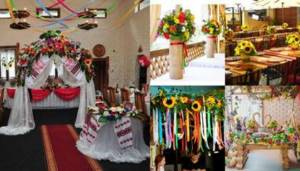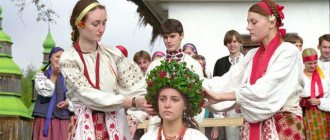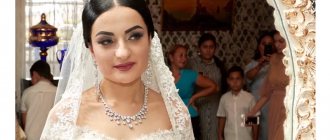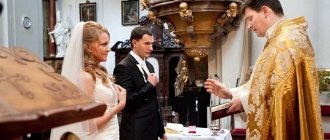Folk songs and polka are integral attributes of a Ukrainian wedding. But the customs don't end there. Just a few years ago this intense fun lasted for a couple of days. Over time, traditions are simplified and shortened, but the essence remains. All details of traditions are best preserved in western Ukraine and Transcarpathia. Let's look at them in order.
Wedding preparations
Heel
They make it large, from pine or spruce branches, in the shape of a horseshoe. They place it above the gate, right down to the ground. At the top, in the center, is an icon, and above it is an embroidered towel. It signifies that there is a wedding in this house.
Embroidered towel
Girls always embroidered a towel, which symbolizes share. In western Ukraine, this tradition never goes out of fashion: almost every girl knows how to embroider and is preparing for the main celebration of her life.
Wreaths
Previously, a wreath was made from wildflowers. They put wreaths on the head (or hand) of the bride and groomsmen and go to invite guests to the wedding.
Request for a wedding
The girl with her friends, starting from her home, bows to the images, to all her relatives and goes out into the street. On the way, when meeting passers-by, they always greet them with a bow.
Entering someone else's house, where future guests live, he bows to everyone, kisses and says: “Mom asked, dad asked, and I ask you to come to my wedding.” At this time, the groom and his groomsmen also ask their relatives.
Loaf
Married women were supposed to bake the loaf. They dressed in festive clothes and sang ritual songs. Nowadays, a loaf of bread is simply ordered from a bakery or bought in a store, since the holiday is not complete without it. The loaf symbolizes the happiness and prosperity of the young.
Newlywed outfits in Ukraine
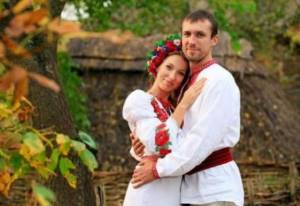
Previously, the girl was dressed in national clothes - an embroidered shirt, a long skirt with a pattern, and a belt. On the head there is a wreath of fresh flowers and ribbons. And now in some regions the bride dresses the same way, goes to the crown, and then changes into a long white dress and puts on a veil.
The guy put on an embroidered shirt that the bride prepared for him, trousers, boots, a belt, and a hat. Now the groom puts on a suit and a white shirt. But in recent years, you can increasingly see embroidered shirts.
LiveInternetLiveInternet

In folk customs and signs, a significant part of the pagan heritage is preserved - healing traditions, song and rhyming spells, the use of herbs and potions, and of course, wedding rituals that still take place.
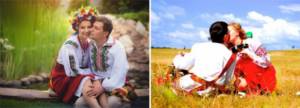
In Ukraine, all this is very noticeable and is still alive, although it is not always clear to the ritual participants themselves.
I ask the mother of the bride - why do you say that the sister should put the first pin in her hair?
He answers - well, that’s what old people think, grandma said...
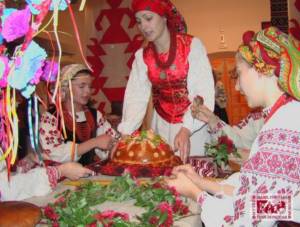
As a makeup artist, I work with brides and often hear very exotic rules that a young woman must follow,
For example:
when doing her hair, she should sit on a chair under which a bucket of water is placed - the water is then poured in the yard under a fruit tree (the meaning here is quite clear - fertility),
You need to attach at least a pin into your hair under the veil, for the most daring ones - a head of garlic (against the evil eye and damage),
hairpins should be inserted into the hair by the sister, if she has one (sharp objects should not be in the wrong hands),
“under the veil” you can’t let anyone in - when they lace up the corset at the back,
the veil is already pinned on the bride's head and falls on the one
whoever is standing next to you - this should not happen, otherwise the family will fall apart because of the homewrecker.
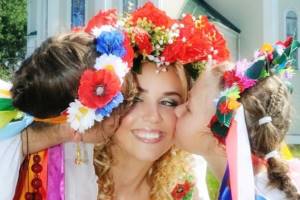
Sometimes you hear enough of such things that it’s time to write a book yourself - about all the wedding signs and rules, and these will only be the signs of my region, and how many of them have been preserved throughout Ukraine...
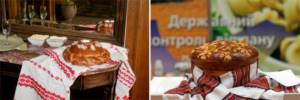
“The Ukrainian word “vesilya” comes from the name of the solar holiday “veseliya”, which was celebrated each phase of the solstice by certain
rituals.
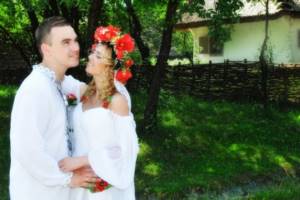
It was before such rituals that marriage ceremonies belonged.
Celebrating spring awakening, people themselves felt an irrepressible desire to love, create a family and continue the family line.
That’s why the vast majority of weddings were celebrated at the time of the spring and summer solstices, less so during the autumn and winter.
Only after the introduction of Christianity did weddings begin to be celebrated mainly in the fall, when all the summer work was over and the harvest was harvested.
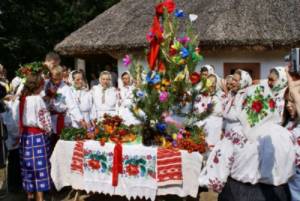
In addition, the spring solstice almost always coincides with Lent, during which married life was strictly prohibited.
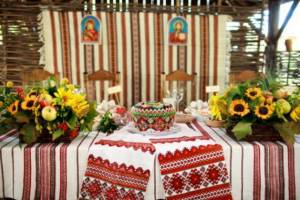
Thus, the spring solstice wedding, which had always been consistent with the cycles of nature, gradually moved and was subordinated to the church calendar.
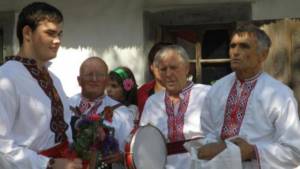
The fact that the wedding was dedicated to the solar gods is evidenced by the attributes and symbols that have been present in the Ukrainian wedding ceremony for centuries:
Loaf, wedding candles, wreaths, twigs, etc.
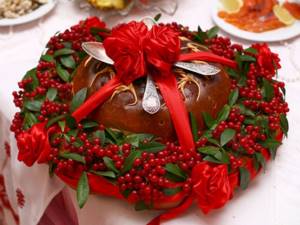
Another remnant of ancient worship is the custom of the newlyweds sitting on a casing or sheepskin turned upside down, as well as a wedding bonfire before the young woman enters the young man’s courtyard, pouring wine on the floor (sacrifice), and the young woman chopping the stove for matchmaking.
The sacrifices to the Gods, the patrons of marriage, were the rituals of cutting Loaf, cutting the hair of the young woman, and ancient wedding songs were original prayers addressed to these Gods.
Later, completely earthly motives were added to the prayer hymns, wishes for happiness to the young.
One of the most ancient wedding songs, which has come down to us in several versions, is a song addressed to Dazhbog.
In Ukraine, the traditions of folk wedding ceremonies prevailed for a long time, but church weddings became mandatory only in the 19th century.
Many church records have been preserved about the obligatory nature of church weddings, but weddings were constantly ignored by the people.
The distrust of church weddings is also evidenced by the facts that the church sanctified the polygamy of princes and boyars, who had three or four wives, and married ones.
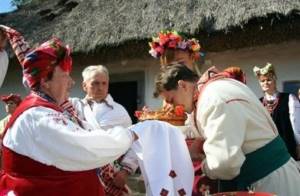
Church marriage, at that time, was not a “sacrament” for Ukrainians, but only a legal act that could be drawn up in advance.
After the wedding, newlyweds could live separately for two or more years until they celebrated the wedding.
Church weddings were also ignored at the beginning of the 16th century.
Only in 1774 did the Holy Synod issue the “highest decree”, which introduced church weddings as a mandatory act and imposed an anathema on those who would violate church rites.
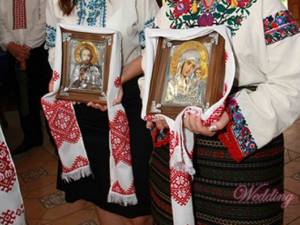
Even those who will live separately after the wedding were punished as for violation of marital fidelity. Only in the 19th century did the church yield to popular custom by allowing people to get married on their wedding day, thus uniting folk and church marriage. Ukrainian folk wedding rituals are divided into three periods: pre-wedding, the wedding itself, and post-wedding.
Before the wedding, they usually celebrate matchmaking, bridesmaids, and engagement.
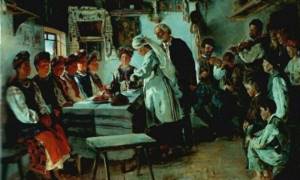
Loaf.
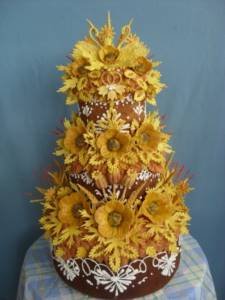
Baking a wedding loaf was accompanied by special rituals and was the most important part of the wedding ceremony.
There are many beliefs and rules associated with baking Loaf.
It was obligatory for the first marriage; widows and widowers were not baked a loaf.
Karavainites were women who were happily married; girls and widows were not allowed. The entire process from kneading the dough to baking the loaf was accompanied by special songs.
In addition to the loaf, cones were baked, which were a symbol of fertility, which were given to all guests.
As well as wedding ritual attributes, rolls and cookies of various shapes were baked (in the form of cows, horses, cockerels, etc.). The children were treated to cookies.

The branch is a melon.
A branch of a fruit or pine tree, decorated with flowers, ribbons, and viburnum.
In some areas, mainly in the south of the country, the twig was wrapped in dough and baked in the oven.
Throughout the wedding, a twig, which symbolizes girlish beauty, stood on the table. At the end of the wedding, the groomsmen broke a piece of a twig, which was also called “devovanie.”
Posad.
Compiled from several parts. The first planting of the young and the young was carried out mainly separately in the house of each of the young. This ritual symbolized respect for the cult of the hearth and the cult of ancestors. The young people were taken out to the courtyard, given a handkerchief in their hands, and sat on a casing in the corner. Before the planting, each of the young people was blessed by their parents. In some areas, the bride, who was being led to the posad, had her road covered with linen bags. The second seating was common to both young people at the wedding.
The third posad is the posad of a young bride after marriage, which symbolized the young woman’s transition from a girl’s state to a woman’s state.
As a rule, mother, brother, elders, boyars, etc. were invited to the posad. Unraveling.
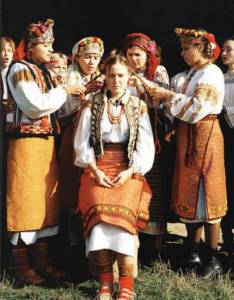
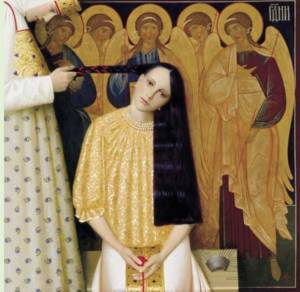
This ritual was performed before the wedding or on the wedding day. The bride was seated on a tub covered with a casing. The brothers or all members of the maternal family took turns unweaving. Then a wreath was placed on the young woman’s head. This custom symbolized maidenhood
purity: the braid is unraveled by one’s own hands, not by strangers. The wedding begins in the home of each of the newlyweds.
Next, the groom assembled the so-called “train” of his boyars, boyfriends, unmarried guys, matchmakers (married women), socialites, etc. The number of wedding ceremonies depended on the wealth of the family and the number of guests. At this time, gifts were being given to the bride in the young woman's house. The young man's train, going to the bride, walked three times around the table or around the tub. “Before the newlyweds, they carry a piece of wood, which they call “gilt.”
The young mother, dressed in a casing 66 that has been turned back, greets the young people in front of the threshold with sill bread, holding it in her casing-covered hands, and a merry choir sings:
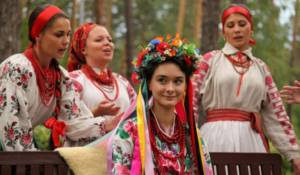
What's wrong with the bones? What's so hairy? Such a shaggy casing, Such a rich son-in-law will be.” “The mother blessed the groom and showered him with oats so that he would be rich. Each participant in the wedding train had his own obligations.
On the way, strangers sometimes stopped the wedding train and arranged a so-called “remeasure”: they set up a table with bread and salt and, having stopped the wedding train, demanded a ransom from the young man.
The groom had to treat the guys. The entrance of the groom's wedding train into the bride's courtyard was decorated with games, which symbolized the pretend battle of taking the castle, which ultimately ended in peace negotiations.
When, after the exchange of wedding rolls between the bride and groom, the guests entered the house, there was an exchange of gifts between the matchmakers, a bargaining between the groom and his young brother for the bride, a dance of the newlyweds, a dance of the unity of the two clans, which the Hutsuls called the “wheel”.
At the end of the wedding dinner, the ceremony of covering the bride's head was celebrated, which symbolized her transition to the female community.
Before the young woman left for the groom's house, a ritual three-time walk around the tub, sent with a towel with bread and salt, was carried out.
The mother led the horses out of the yard, blessed her daughter, and gave her bread and chicken. In front of the groom's courtyard, the wedding train was transferred over a ritual fire, and in the south they were poured with water.
These customs are a tribute to ancient magic, which symbolized purification by fire and water. After a number of ceremonies, the newlyweds were prepared for their wedding night.
The bride was dressed in a new shirt, the matchmakers made the bed, the groomsmen or the senior boyar stood near the chamber where the newlyweds would sleep.
In the morning, the matchmakers examined the shirts and bed of the newlyweds. If the girl turned out to be honest, then the celebration knew no bounds; those present jumped on the tables, benches, shouted and sang.
The girl's mother was sent gifts and news of the happy ending of the wedding night, thanking her for her daughter.
If the girl turned out to be dishonest, the holiday stopped and songs began that desecrated the young generation. Sometimes the girl’s parents wore straw collars, and that was the end of the wedding.
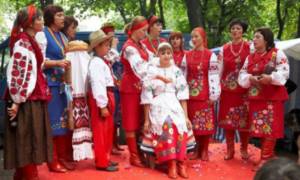
In some areas, boys hung a white flag on the tallest tree, which meant a girl's shame.
Then the girl’s brother had to climb a tree to remove this flag, but they interfered with him in every possible way and mocked him (Kiev region). When the wedding ended happily, the girl’s parents and the young man’s relatives were invited in the morning.
Here the banquet began again, the presentation of gifts to the young, which was accompanied by songs.
On Monday, a ritual of cleansing with water was also celebrated, which was later replaced by the bringing of young water from the well and the washing of the newlyweds and all the guests.
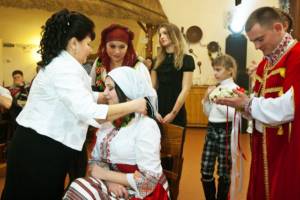
On this day there was a lot of fun with dressing up, and they sang humorous songs.
Red symbolism predominated: belts, ribbons, red scarves or a young spare tire, even vodka was tinted with red juice.
Everything was supposed to symbolize the birth of a family.
On the same day the loaf was divided.
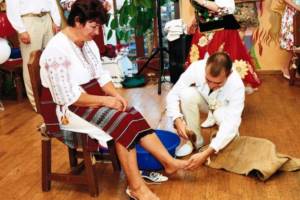
On Tuesday, festivities called “gypsyism” were celebrated, when people dressed up, stole the trigger, etc.
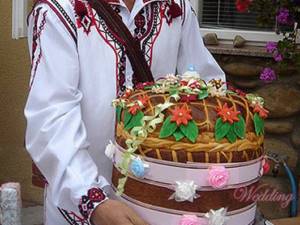
Only adults celebrated; children and youth did not take part in these entertainments.”
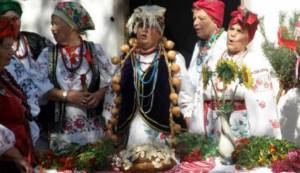
source
https://www.dimukraine.com/svadba.shtml
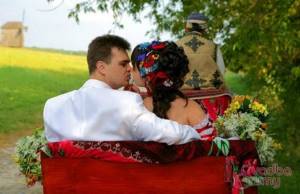
Ukrainian wedding
The action begins in the morning. Any actions of this day are accompanied by songs and music (accordion, violin and trumpet). The bride sends her bridesmaids with an embroidered shirt to the groom. He is sold a shirt, and in return the bride is given a scarf, which after the wedding will be tied on her head. The guy is dressed, he bows and heads to his beloved.
Arriving at the bride, the groom must pay a ransom to the brothers and sisters for the sister he takes from them. He asks to show the bride. At first she doesn’t come out, they may even send a fake (a man in disguise).
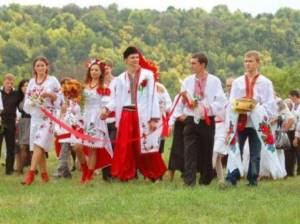
Afterwards the bride comes out and invites everyone into the house. A crown (called a koruna) is placed on her head under the veil, symbolizing innocence and purity.
The newlyweds stand side by side, bow to everyone, asking for blessings, get into the transport, their parents sprinkle them with holy water, sprinkle them with cereals that call for prosperity, and the whole procession heads to the church for the wedding.
Third stage - Inviting guests
Following the Ukrainian tradition, the bride and groom invite all intended guests themselves. The girl gathered her girlfriends, with whom they baked small “bumps” buns in exchange for an invitation card to the wedding. The cones were handed personally to invited guests with the phrase “Mom has gone, Tato and we have gone.” According to custom, on Saturday evening, before the wedding, Parubotsky fun and a hen party (bachelor and bachelorette parties) were held, where the future groom had to have a nice walk, and the girl, with her friends, did needlework and created a talisman for the new family - “Giltse”.
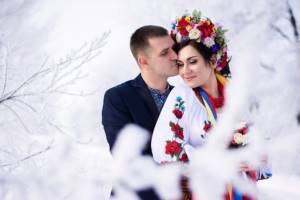
Wedding feast
After all the canons have been completed, already hungry, you can go to a cafe. At the entrance, the newlyweds are greeted by their parents and given bread in their hands so that the family always has prosperity. The newlyweds accept gifts and congratulations, the guests sit down at the table and the celebration begins. According to tradition, the bride is kidnapped and asked for ransom from the groom because he could not save her.
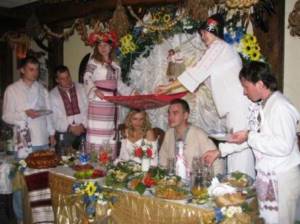
At the end of the feast, the girls remove the bride’s veil (wreath) and put on a scarf, making it clear that she has become a wife and mistress. The bride dances with each girl, putting her veil on her head so that they get married faster.
The guests sing “Many Years” to the young people. Now fireworks or balloons are often released. The newlyweds go to the wedding bed, and the guests continue to have fun.
In different regions, the wedding ends in different ways - it can last another day: the guests dress up as different fairy-tale characters, and on the third day the parents are taken for a ride on a chaise, bathed in water and a swamp - symbolizing health and prosperity. A week later, the closest relatives gather for a festive dinner.
Matchmaking
The first Ukrainian wedding ceremony, from which it all begins, belongs to the preparatory (pre-wedding) stage. According to this ritual, relatives (father, uncle, older brothers) - matchmakers from the groom's side - go to the bride's house. They are the first to start an official conversation with the Ukrainian girl’s parents on the topic of wedding. The art of such a dialogue is to avoid getting a pumpkin (in Ukrainian - watermelon), which symbolizes the girl’s decisive refusal.
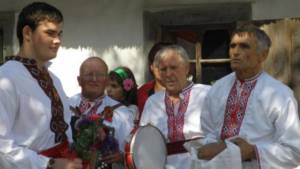
Following long-standing Ukrainian wedding customs, matchmakers at that time had to go to the matchmaking not empty-handed, but taking with them a loaf of freshly baked bread. It was placed on the table in the bride’s house, after which the one who was the authority in the family began an exciting conversation with the parents of the girl getting married. If the whole ceremony was successful, then the bride, who was nearby all this time, took the brought bread and cut it, saying the following words: “I cut this bread to give you my vow, and you accept me as your child.”
After this remark, according to the wedding tradition of the Ukrainian people, the cut loaf was placed on a towel and given to the matchmakers. They, in turn, responded with the following speech: “Thank you to the red maiden for embroidering such a cassock towel.” Such mutual courtesies of the Ukrainians symbolized a successful agreement, after which it was decided to immediately agree on further actions of the pre-wedding stage - bridesmaids and engagement.
Bride
During this wedding ceremony of the Ukrainian people, the groom’s parents tried to seem as successful and friendly as possible in order to once again win the favor of the bride’s family. According to tradition, when the show took place, the girl had to demonstrate all her skills. She showed her future mother-in-law what kind of housewife she was. how quickly and deftly he copes with housework. It was important to show all your wonderful culinary abilities in order to win the favor of the groom's mother.
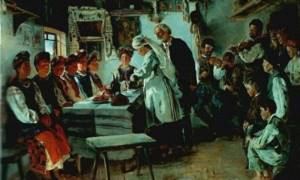
Immediately after the bridesmaid ceremony, according to the traditions of Ukraine, there was an engagement - a kind of ritual of final consent to marriage, which was announced in the presence of witnesses (publicly). The bride and groom were tied with a towel, their hands tightly connected (this was carried out to “legally” seal the wedding contract and did not have retroactive effect). After which the bride had to bandage the matchmakers and give them gifts (scarves, shirts, linens).
Wedding menu in Ukrainian traditions
A mandatory attribute of a Ukrainian wedding is a loaf. In the old days, a lot of attention was paid to this baking. It was of great importance how the loaf would turn out when baked. Ideally, it should not be crooked, skewed, cracked, or burnt. If the finished loaf had these defects, it was an omen of an unsuccessful marriage, difficulties, quarrels and even the death of one of the spouses. Nowadays, the loaf should be tall, lush and, undoubtedly, beautiful. To decorate it, they use figurines of doves or swans made of dough, viburnum berries, small flowers and tie it around the circumference with a red ribbon.
No less important is the wedding cake. It should be designed according to the style. For decoration you can use sunflower flowers, poppies, cornflowers, daisies, wheat ears, making them from colored mastic.

There must be dishes of Ukrainian national cuisine on the tables, namely:
- dumplings with various fillings;
- cabbage rolls;
- homemade sausage;
- potato pancakes;
- salo;
- nalistniki with curd filling;
- baked fish.
Drinks you can offer guests are vodka, various liqueurs, kvass, and compote.
Editor's choice: Heart for a wedding: how to make it yourself

How to decorate a hall for a wedding celebration?
In order to maintain a unified style of the wedding ceremony, you need to think in advance about how the decoration of the hall will look. Preference should be given to bright colorful colors. On the walls of the room you can place folk musical instruments, pottery, and embroidered towels. You can decorate the hall with wreaths of flowers, bunches of viburnum, and colored bright ribbons.
Additional decor will be created by embroidered linen tablecloths on the tables and flower arrangements in ceramic vases. Instead of chairs, you can use wooden benches or wicker furniture. The photos presented here will help you get design ideas.
Editor's choice: Wedding in rose quartz color, photo review
